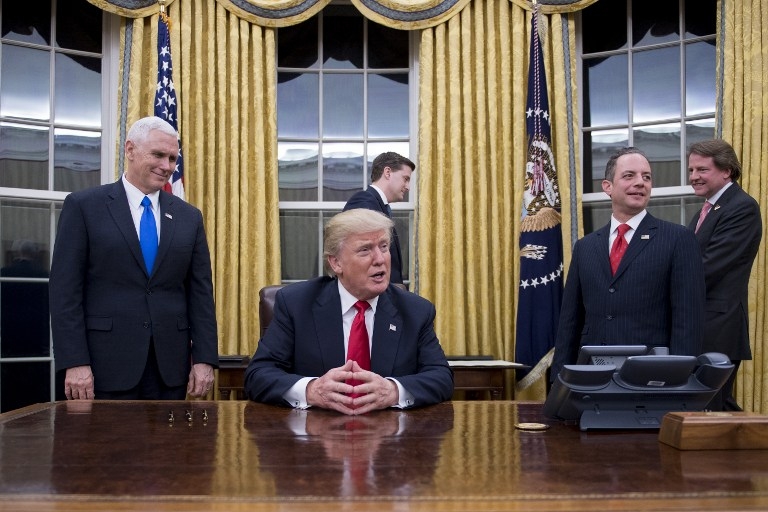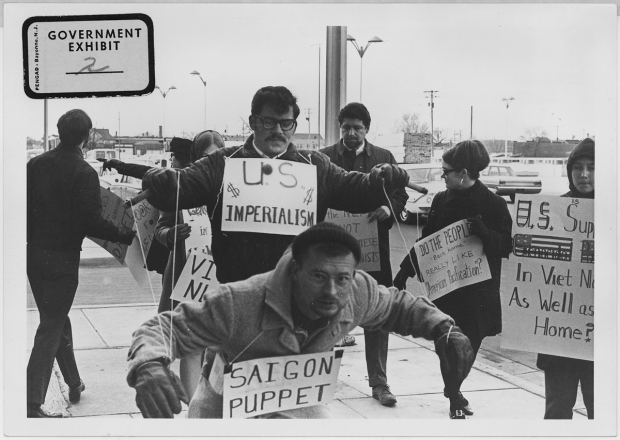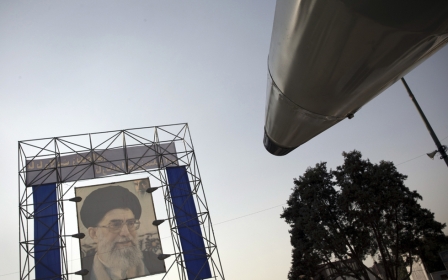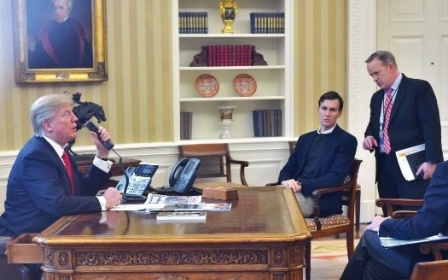Trump versus Iran: Three flashpoints that could spark war

It is simplistic to assume that any nuclear deal between Iran and the US can endure while relations between Washington and Tehran are in turmoil and other areas of conflict between the two states remain active and unresolved.
The two states should build on the nuclear accord and begin a détente process. If not, then it is only a matter of time before the deal will crumble under the weight of deep-rooted hostilities.
Iran’s leader cannot appear weak before the Americans. He has no choice other than to confront the US
But aside from the nuclear issue, there still remain three other pressure points between Iran and the US.
Iran defeats US efforts
First, Iran has aggressively challenged US hegemony in the region. The Americans have mounted relentless efforts during the last four decades, using every means - short of a war - at their disposal to undermine and seek regime change in Iran, from the support of Saddam Hussein in his eight-year bloody war (1980-1988) against Iran, to covert operations, cyberattacks, and supporting armed opposition groups inside the country, to crippling sanctions.
The US has never missed an opportunity to either stop the Iranian government from expanding its influence in the region or seek to overthrow the system entirely. But Tehran has always been able to gain the upper hand.
This is most evident in Iraq, which was expected to come under the US sphere of influence following the 2003 invasion, and Syria.
For instance, in 2014, all the countries in the region were invited to Syrian peace talks in Geneva. Iran was excluded due to American opposition.
But since then the situation began to change drastically in Syria. In January this year there was a new round of talks on Syria in Kazakhstan after the fall of Aleppo in December - a defeat for the rebels and a big win for Iran. This time, however, neither the US nor any of its regional allies were invited to the peace talks. Tehran opposed their participation.
Revolutionary goals
Second, the conservatives, the dominant political faction in Iran led by Ayatollah Ali Khamenei, Iran’s supreme leader, insists on maintaining the revolutionary nature of Iran’s political system. It aims to change the status quo in the region.
Iran has organised a massive paramilitary force in Syria, Israel’s backyard. These militia are likely to remain there even in the post-Assad era
This has the potential to destabilise those regimes that are US allies, specifically conservative sheikhdoms in the Persian Gulf, most notably Saudi Arabia. Riyadh feels threatened by Tehran because Saudi’s Shia population is concentrated primarily in its Eastern Province, home to Ghawar, the largest oil field in the world; and the Houthis, the Zaidi Shia movement in Yemen, south of the Saudi borders that they are presently at war with.
Since the 1979 bloody Shia uprising, inspired by the Iranian Revolution that happened in Qatif, in the Eastern Province, there have been several instances of clashes between Shia Saudis and the Saudi police and anti-riot forces, some of which have ended in gun battles.
Hostility to Israel
But the third - and perhaps the most significant - element responsible for shaping the conflicting relations between Iran and the US is the Iranian government’s hostile position toward Israel, which is due to profound religious, historical, political, and socio-psychological factors. That situation has only worsened with Iran’s success in Syria.
Following the example of the Lebanese militant group Hezbollah and its proxies in Iraq, Iran has organised a massive paramilitary force in Syria, Israel’s backyard. These militia are most likely to remain there even in the post-Assad era. This is a real threat to Israel’s security which, along with an uninterrupted flow of oil from the Middle East, is one of the two pillars which determine US policy in the region.
Public opposition, to the best of my knowledge, has never been able to stop governments from going to war
While the US is on the defensive, the Iranian government has strengthened its position with the expansion of its ballistic missile programme, and its unwavering support of Hezbollah in Lebanon.
But Washington’s hands are tied. It would have to either stop Iran, or force it to pay a heavy price in pursuing these policies. The major obstacle? The nuclear deal.
As explained in an earlier analysis, for the Americans to confront Iran it would either have to impose new stinging sanctions on Tehran, or violate the nuclear deal by refusing to renew waivers on existing sanctions under a manufactured or exaggerated pretext.
The most likely outcome of any of these approaches is the collapse of the nuclear deal. And under the presidency of Donald Trump, who repeatedly has called the agreement the “worst deal ever negotiated,” it is only a matter of time before one of these two approaches is adopted.
Scenarios of tension
Two scenarios can happen.
First, the Europeans may not fall in line with the US if Iran still remains committed to the nuclear accord. There would then be significant tension between Europe and the US, should the Trump administration start to penalise European entities which do business with Iran.
While the Europeans may become furious at the US position and the collapse of the deal, it is very unlikely that they would become engaged in an economic war with Washington over Iran.
The second, and more likely, scenario would have dissatisfied Europeans succumbing to US pressure and withdrawing from the lucrative Iranian market without imposing their own sanctions on Iran, as they extensively did in 2011.
At some point, Washington will run out of patience and a military operation involving aerial forces, missiles and unmanned drones may become inevitable
Iran’s retaliatory reaction to such an eventuality would be an immediate expansion of its nuclear programme. Just a few days ago, Iran’s nuclear chief, Ali Akbar Salehi, said to Canada’s CBC News: “We can very easily snap back and go back … not only to where we were, but a much higher position, technologically speaking.”
He added: “I don’t want to see that day. I don’t want to make a decision in that course, but we are prepared.”
The reality is that Iran’s leader, the ultimate decision maker on foreign policy, cannot appear weak before the Americans. He has no choice other than to confront the US. The expansion of the nuclear programme would be accompanied by the further development of the country’s ballistic missiles programme.
Some may argue that engaging in a war with Iran would be against the isolationist doctrine advocated by Donald Trump.
Conflict inevitable?
But the question arises: can Iran advance and expand the above two programmes indefinitely and hope that Trump sits idle as a mere spectator?
Realistically, at some point, Washington will run out of patience and a military operation involving aerial forces, missiles and unmanned drones may become inevitable.
How, and on what scale, Iran will react is unclear.
But one thing is clear: Iran will react harshly and with resolve. A war will emerge that as remarked by Secretary of Defense, Leon Panetta, in 2011, “could consume the Middle East.”
On 16 January, the outgoing US President Barack Obama rightfully urged his successor to remember that the Iran nuclear deal prevented “another war in the Middle East”.
Meanwhile, let us not forget that the US non-interventionist president, Woodrow Wilson, after resisting becoming entangled in World War I for three years, was eventually compelled to enter the war and Congress vote to declare war on Germany.
Dragging the people into war
Many observers might argue that, after the experiences of Afghanistan and Iraq, the American people do not have the appetite for another war.
But when, in the history of the United States, have people been able to stop the government from going to war, especially during the last 50 years, when the country has been constantly engaged in small and large-scale conflicts?
Even in the case of the Vietnam War, people put pressure on the government to end the war – but public opposition, to the best of my knowledge, has never been a factor capable of stopping governments from going to war.
Misinformation, disinformation, propaganda and fake news campaign can all convince the public that war is necessary.
Hermann Goering, one of the leaders of the Nazi Party, made the following comments during a conversation with American psychologist, Gustave Gilbert, at the Nuremberg trials in 1946.
“Naturally, the common people don’t want war; neither in Russia nor in England nor in America, nor for that matter in Germany. That is understood. But, after all, it is the leaders of the country who determine the policy and it is always a simple matter to drag the people along, whether it is a democracy or a fascist dictatorship or a Communist dictatorship…
“Voice or no voice, the people can always be brought to the bidding of the leaders. That is easy. All you have to do is tell them they are being attacked and denounce the pacifists for lack of patriotism and exposing the country to danger. It works the same way in any country.”
- Shahir Shahidsaless is an Iranian-Canadian political analyst and freelance journalist writing about Iranian domestic and foreign affairs, the Middle East and US foreign policy in the region. He is the co-author of Iran and the United States: An Insider’s View on the Failed Past and the Road to Peace. He is a contributor to several websites with focus on the Middle East as well as the Huffington Post. He also regularly writes for BBC Persian. You can reach him at [email protected] or follow him on Twitter @SShahisaless.
The views expressed in this article belong to the author and do not necessarily reflect the editorial policy of Middle East Eye.
Photo: US President Donald Trump (C) speaks to the press as he waits at his desk before signing conformations for General James Mattis as US Secretary of Defense and General John Kelly as US Secretary of Homeland Security, as Vice President Mike Pence (L) and White House Chief of Staff Reince Priebus (R) look on, in the Oval Office of the White House on 20 January 2017 (AFP)
This article is available in French on Middle East Eye French edition.
New MEE newsletter: Jerusalem Dispatch
Sign up to get the latest insights and analysis on Israel-Palestine, alongside Turkey Unpacked and other MEE newsletters
Middle East Eye delivers independent and unrivalled coverage and analysis of the Middle East, North Africa and beyond. To learn more about republishing this content and the associated fees, please fill out this form. More about MEE can be found here.







